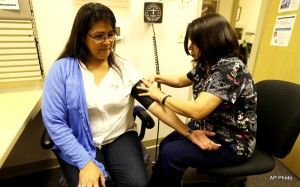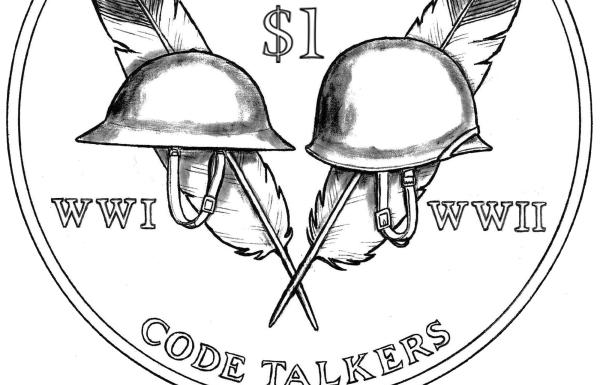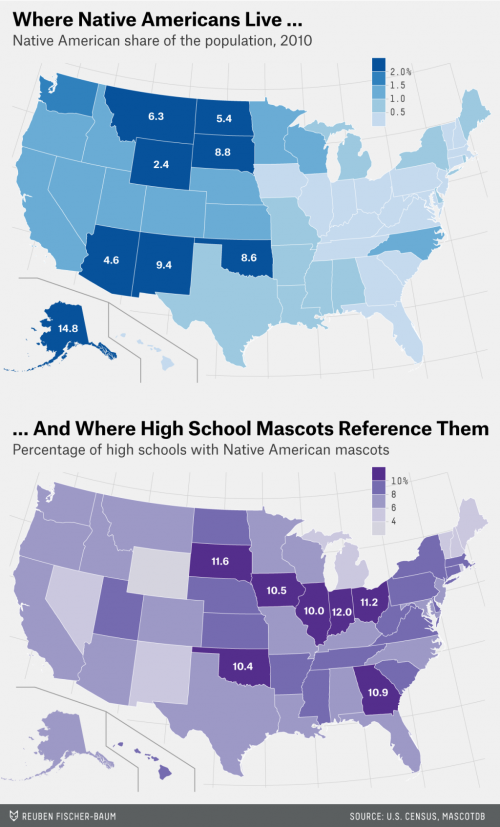Slowly but surely, tribal governments — especially those in Alaska — are receiving millions of dollars in decades of unpaid contract costs from the Indian Health Service and Bureau of Indian Affairs.

WASHINGTON — Tribal health programs working to serve native people are not seeing funding of administrative costs keeping pace with need, and the Indian Health Service and the Bureau of Indian Affairs owe millions to tribal governments.
“The federal government has broken too many promises with tribes and though we have more work to do, I am pleased that we are seeing good progress with Alaska tribes receiving the money they are owed,” Alaska Sen. Mark Begich told the Alaska Native Tribal Health Consortium last month. “Failure to pay the full costs is unacceptable and I will continue to use my position on the Senate Indian Affairs Committee to keep up the pressure on the federal government.”
The IHS, a Department of Health and Human Services agency, provides health service systems for about 2.2 million of the nation’s estimated 3.4 million American Indians and Alaska Natives.
Funds allocated by the IHS, currently $4.4 billion per year, go toward administering medical care to tribes or are turned over to tribes for them to administer the care themselves. The IHS had been failing to provide full payments of contract costs until the Supreme Court ruled in June 2012 that the government must pay, determining that the tribes had been underpaid “between 77 percent and 92 percent of the tribes’ aggregate contract support costs” during previous decades.
Yet, according to Jacqueline Johnson Pata, executive director of the National Congress of American Indians, “payment has not happened.”
“The class action lawyers recently reported to NCAI on the lawyer’s discussions with the Justice Department. Although they couldn’t share much information, they did explain that there are close to 9,000 claim years at issue involving about 500 tribes and 19 years worth of contracts (1994-2013),” she told the U.S. Senate Committee of Indian Affairs last year.
Sen. Begich introduced Senate Bill 2669 in July to the Senate Appropriations Committee
to mandate funding for certain payments to Indian tribes and tribal organization. Additionally, the federal government has treaty and statutory obligations under the Indian Self-Determination and Education Assistance Act of 1975, which requires the government to contract with tribes to operate BIA and IHS programs. The agreement between the government and tribes is embedded in Article I, Section 8, of the U.S. Constitution.
At the end of 2013, less than 1 percent of thousands of claims in more than 200 lawsuits filed by tribes seeking a combined $200 billion had been settled — just 16 claims of an estimated 1,600.
Of the 566 nations the federal government recognizes, 229 are spread across the vast 572,000 square miles of Alaska, where they occupy small villages in remote areas — many only accessible by air or boat. For these tribes in remote areas, seeing a doctor might be inconvenient, to say the least, and almost definitely costly.
Lead counsel in the cases establishing government liability for IHS’s failure to pay, Lloyd Miller, an attorney based in Anchorage, Alaska, said IHS is severely underfunded.
“IHS is a prepared health plan paid for with a lot of blood and millions of acres of land,” Miller said. “Because the government took away their lands, there’s a responsibility.”
IHS gets $4.4 billion from Congress annually for what’s estimated to be a $15 billion need to meet the costs, he said.
Miller represents about 60 tribes, each with several claims filed for the costs owed.
In an August 2007 letter to the Senate Committee on Indian Affairs requesting an oversight hearing, Alaskan tribal health care providers reminded the committee that the Indian Self-Determination Act requires money to provide federal trust responsibilities.
“We write to once again call your attention to the grave crisis we face as a result of insufficient contract support cost appropriations which, together with Indian Health Service policies, have left our tribal organizations with annual shortfalls running from $2 million to over $8 million. We respectfully request that the Senate Indian Affairs Committee convene an urgent oversight hearing this Fall, to review what has become a genuine crisis in Indian country, and a crisis that has seriously eroded the national policy of Tribal self-governance and the delivery of quality health services to Alaska Native people,” the letter stated.
By August of this year, 12 of Alaska’s tribal health providers received $449 million to resolve contract support costs disputes with the IHS. Another 11 providers were still in negotiations. The Alaska Native Tribal Health Consortium, serving more than 143,000 native people, received the largest payment, with a $153 million settlement that includes $115.5 for past-due costs and $37.7 million in interest. At about $128 million, Southcentral Foundation received the next largest settlement.
The NCAI has been working with tribes and the IHS on contract costs since the Indian Self-Determination Act went into effect.
The congress is hosting the annual Tribal Unity Gathering and Legislative Impact Days on Sept. 16 and 17 in Washington. During the event, tribal leaders and representatives will meet with their delegates to the U.S. Congress to encourage action on important delegation before this session ends. IHS appropriations will be among the issues discussed.
“There’s strong support from the House and Senate,” said Amber Eberb, program manager of the NCAI Policy Research Center. “There’s quite a few champions who understand that tribes administering their own programs to respond to their community needs is more effective than a federal agency.”
There’s still progress to be made, Eberb said.
“Contract costs and other treaty issues should not be considered discretionary but mandatory,” Ebarb said. “All program money that uphold treaty agreements should be mandatory. It’s morally correct to do. Perhaps a little difficult to do right now.”
Disparities in well-being
American Indian and Alaska Native (AI/AN) death rates were nearly 50 percent greater than rates among non-Hispanic whites during 1999-2009, according to a study by the Centers for Disease Control.
The study was carried out by the CDC’s Division of Cancer Prevention and Control, the CDC’s National Center for Health Statistics, CDC researchers, the IHS, and partners from tribal groups, universities and state health departments.
It revealed:
Among AI/AN people, cancer is the leading cause of death, followed by heart disease, while the opposite is true for other races studied;
- Death rates from lung cancer have shown little improvement in AI/AN populations. AI/AN people have the highest prevalence of tobacco use of any population in the United States;
- Deaths from injuries were higher among AI/AN people compared to non-Hispanic whites;
- Suicide rates were nearly 50 percent higher for AI/AN people compared to non-Hispanic whites, and more frequent among AI/AN males and persons under age 25;
- Death rates from motor vehicle crashes, poisoning, and falls were two times higher among AI/AN people than for non-Hispanic whites;
- Death rates were higher among AI/AN infants compared to non-Hispanic white infants. Sudden infant death syndrome and unintentional injuries were also more common. AI/AN infants were four times more likely to die from pneumonia and influenza;
- By region, the highest mortality rates were in the Northern Plains and Southern Plains, while the East and Southwest had the lowest.
“Many of the observed excess deaths can be addressed through evidence-based public health interventions,” the report concluded.
In November 2013 testimony before the Senate Committee on Indian Affairs, Alaska Sen. Lisa Murkowski said:
“I listened very intently yesterday at the tribal summit when the President spoke. I went there specifically to hear what he was going to say on the issue of contract support costs. What I heard him say is, we have heard you loud and clear, but we are still working to find the answers. I don’t think we need to work to find any answers. I think that the court laid it out very, very clearly. It said that full reimbursement will be provided. So we have to make that happen within that budget. We have to make that priority.”
Murkowski said she had listened to the stories of the impact of lack of funds, saying, for example, that the regional health provider in Juneau had to close its alcohol treatment facility. Further north, in the Yukon Delta, the regional health provider laid off 20 employees, permanently closed 40 vacant positions, and reduced services for elders, she continued.
The impacts of the sequestration, she said, also meant that tribes would not be able to reduce waiting times at emergency rooms or outpatient and dental clinics.
“The impact, I think we recognize, has been significant,” she said.
Murkowski submitted comments she received from Alaska Natives around the state, including the Association of Village Council Presidents.
Proposed Increase for IHS Budget
“Tribes have not recovered from sequestration that resulted in across-the-board cuts to all federal programs that tribes are reliant upon. Nowhere was this more impactful than to the Indian Health Services, where due to sequestration, continuing resolutions, and the 16 day government shutdown — healthcare to Indian people was jeopardized,” U.S. Senate Committee on Indian Affairs Chairman Jon Tester, of Montana, said in March.
Tami Truette Jerue, tribal administrator and director of social services for the Anvik Tribal Council in Alaska addressed the committee’s oversight hearing in February. The Anvik are an Athabascan village of about 275 members on the west bank of the Yukon River.
Jerue represented the 37 federally recognized tribes that make up the Tanana Chiefs Conference, an inter-tribal health and social services consortium that serves an area of Interior Alaska that is roughly the size of Texas.
She delivered a message from more than 200 tribes across Alaska:
“It is absolutely essential that, without regard to technical land titles and the technical Indian country status of lands or tribal communities, our Tribes must have the tools necessary to combat drug and alcohol abuse, domestic violence, and violence against women. Fighting these scourges in our communities and healing our people cannot be made to stand on technicalities. We need to get to work, and now. And we need Congress’s help to do that. The State is not the problem, because the State is nowhere to be found in most of our Villages….
“Today, the tribes of Alaska come to you, not as victims of a failed governmental policy, but as powerful and responsible advocates for our people. We are stepping up to do what we must do. But without equally firm action from Congress, our people will suffer, we will continue with decades more of litigation battles and loopholes will continue to be found which deny our tribes the funding necessary to improve law and order in our communities.”
In the budget for the 2015 fiscal year, the Obama administration proposed a 4.5 percent increase for IHS, representing a $200 million increase over the current level to $4.6 billion.
The 2015 budget request includes:
- An additional $50 million to help obtain health care from the private sector through the Purchased/Referred Care program (formerly known as the Contract Health Services program). This program allows for the purchase of essential health care services that the IHS and tribes do not provide in their local facilities;
- An additional $71 million to support staffing and operating costs at four new and expanded facilities;
- An additional $30 million to fully fund the estimated amount of contract support costs for new and expanded contracts and compacts in fiscal year 2015. This will help tribes cover the cost of administrative functions for compacts or contracts established under the authority of the Indian Self-Determination and Education Assistance Act;
- An additional $31 million to address medical inflation costs;
- Additional funding to pay costs for new tribes and restoration of reductions in the fiscal year 2014 operating plan.
In his statement, Tester noted the “positive highlights” in the budget request.
“The Committee is pleased that the Administration finally understands its legal obligation to fully fund Contract Support Costs for the both the Indian Health Service and Bureau of Indian Affairs,” Tester said. “I am particularly encouraged by the $11 million increase for social services and job training to support an initiative to provide a comprehensive and integrated approach to address the problems of violence, poverty, and substance abuse.”
Covering IHS shortfalls with the Affordable Care Act
The Southeast Alaska Regional Health Consortium and more than 50 tribes wrote a letter to President Obama on Oct. 13.
In part, it said, “Among your administration’s most important achievements has been the development of historic settlements with Indian Tribes in several major litigations, its advocacy for amendments to the Indian Health Care Improvement Act and the Violence Against Women’s Act, and its commitment to critical appropriations measures. But when it comes to honoring the Nation’s commitment to the contracting and compacting Tribes who were historically, and illegally, underpaid, and who continue to be underpaid, the administration has permitted fiscal concerns to eclipse the imperative to do justice and to honor the nation’s obligations.”
In July the IHS reached a settlement with the consortium for claims during the years 1999 through 2013. The payment — $39.5 million plus interest — totals about $53 million.
“A lot of tribes had to close down programs because of lack of funds,” Andrea Thomas, outreach and enrollment manager of SEARHC, told MintPress News. “Part of what the settlement can do is bring back what was lost.”
Alaska did not create reservations like the 48 contiguous states, and many Native communities formed consortiums, like SEARHC, to use IHS funding for health care to serve them all.
SEARHC is a nonprofit tribal health consortium of 18 Native communities which serves the health interests of the Tlingit, Haida, Tsimshian, and other Native people of Southeast Alaska. In 1982, the consortium took over operations at the IHS clinic in Juneau, and then took over operations at Mt. Edgecumbe Hospital, formerly an IHS-run facility, in 1986.
“In Alaska we have the highest cost of health care in the nation,” Thomas said. “There’s vast wilderness surrounding each place. In order for me to get out of my community, I’d have to fly or take a ferry. This gets incredibly expensive.”
Many Alaskan villages have a community health clinic, but complicated procedures such as chemotherapy or serious surgeries, require patients to go to hospitals at regional hubs or to the Alaska Native Medical Center in Anchorage. The burden is on the tribal health consortium to pay the costs of a commercial jet, float plane, ferry, or boat.
If a medical evacuation helicopter is needed, it would cost SEARHC about $95,000 — a cost that could be absorbed by the Affordable Care Act.
“The issue is that IHS only provides about half the money for services,” Thomas said. “We rely on other revenues like grants and billing Medicare and Medicaid. If native people enroll, it puts more money back and we could offer more services or expanded services.”
Further, a member of a federally recognized tribe can get a lifetime exemption. Alaska Natives and American Indians are exempt from Affordable Care Act tax penalties because they receive care through the IHS. But through the new health care scheme, they are eligible for subsidies from private insurance. Thomas said that those who fall between 100 percent and 500 percent of the federal poverty level pay a monthly premium, but no deductibles or out-of-pocket expenses.
Yet, of more than 100,000 self-identified Alaskan Natives or American Indians, only 115 had signed up for health insurance through the Affordable Care Act as of April.
“Not a lot of people realize what the Affordable Care Act does for Alaskan Native people,” Thomas said.
Coverage also extends to Native people who are not enrolled members of a federally recognized tribe and meet federal guidelines. Thomas said they can receive a lifetime hardship exemption, rather than a tribal exemption, and there may be some out-of-pocket expense.



















